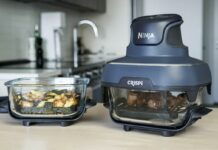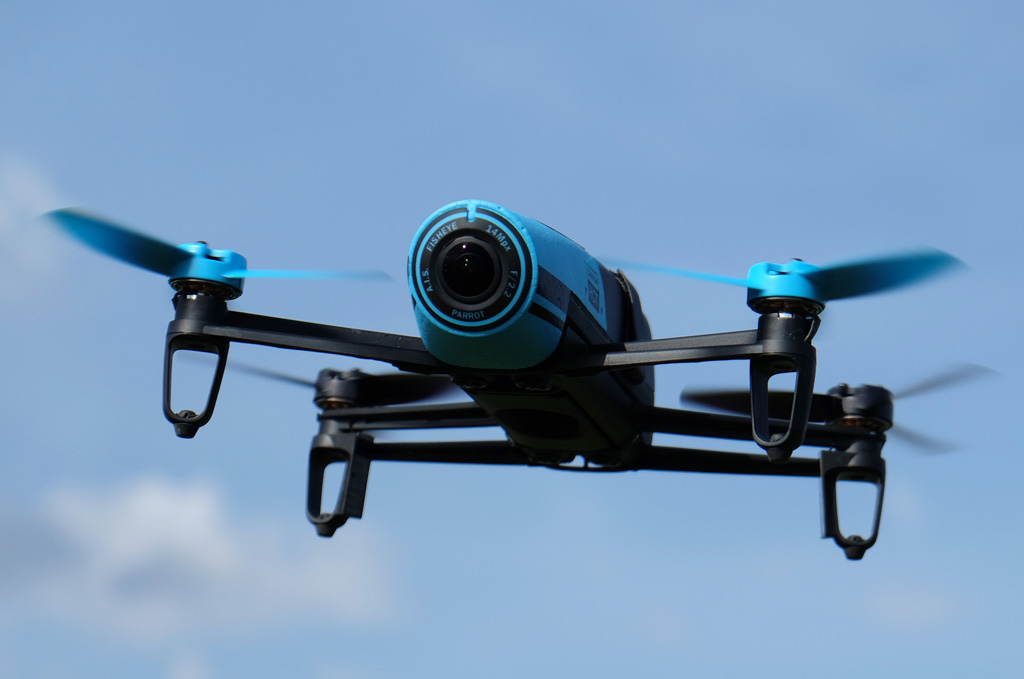
Flying a drone is fun. Ask anyone who has done it, even for a fleeting moment or two, and they will likely refer to the exhilarating feeling in controlling a device that can see from various angles and heights. Considering how popular drones are becoming, Parrot’s Bebop comes at a time where the act of flying itself needs to be handled with greater precision, while offering an easier point of entry for those getting into it for the first time. Here is my experience with it, including a short video.
I’ve become familiar with Parrot’s drones going back to the first AR.Drone in 2011. That one couldn’t flip or do any tricks. It wasn’t as stable, didn’t have an HD camera onboard and battery life was all of five-to-10 minutes. The AR.Drone 2.0 brought things along, while the Bebop offers all that and more in a form factor that is considerably smaller.
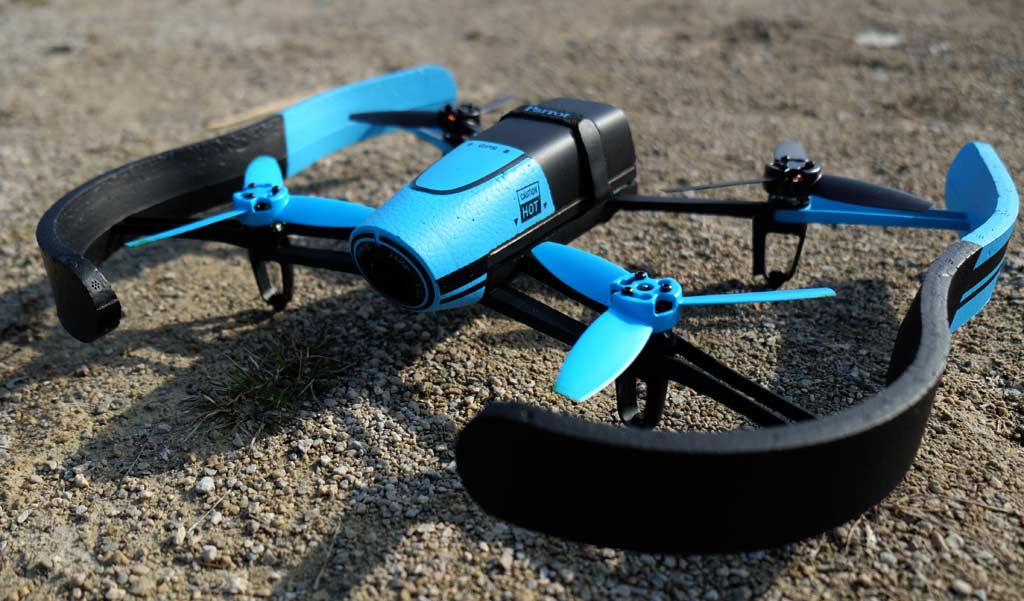
Tough or fragile?
You would have to feel the Bebop in your hands to understand how it feels both tough and fragile at the same time. Its body is made up mostly of plastic, not metal, and coupled with the lightweight body, it’s easy to get the impression that a hard landing or head-on impact will essentially destroy the drone.
The Bebop is a quadcopter with four rotors held together by a hull made of rigid plastic and dense foam that enables it to fly without too much weight, and maintain its stability, in the process. The battery slides on the backside of the hull, requiring it be plugged in to a protruding connector first. That connector literally comes with a looped string attached to fish it out, since it’s not nestled in place. After some initial frustration, I managed to get the hang of it and had no problem plugging and unplugging it. Keeping it in place is a Velcro strap that tightly wraps around.
The protective frames shielding the rotors, particularly for indoor use, are also made of the same dense foam. These have some give in them, and are arguably harder and tougher than those used in the AR.Drones, despite being thinner and lighter. Parrot smartly chose to include wedge clips that hook onto the frame under the rotors on all four sides, simplifying the move from indoor to outdoor use. The AR.Drones had separate hulls for outdoor and indoor flight.
The front face has a 14-megapixel camera has a wide lens with a slight fisheye effect that is also capable of shooting 1080p HD video at 30fps.
Flying high
Setting up the Bebop to fly is not all that different from previous Parrot drones. After turning it on, I connected to its Wi-Fi network and used the free FreeFlight 3 app for iOS or Android to get up and flying. The control scheme and heads-up display on the app is essentially the same as it’s been for other Parrot robots. The learning curve is more on the flying itself than anything else.
If you’ve flown Parrot’s previous drones, then it won’t take long to appreciate how the Bebop works. It does much of the same things its predecessors did, only it manages to do so with more grace. It stabilizes faster, is more responsive to controls and, of course, has a better camera. It can do about four different tricks by double-tapping the smartphone or tablet screen, though it can only do whichever trick is selected. Doing them in any kind of sequence requires some quick handiwork that takes time to grasp.
Wind gusts can throw it off a little, elevating or pushing it from its hovering position. Having built-in GPS and a Return to Home option helps assuage understandable fears of the Bebop going out of sight and potentially being lost or hurting someone. Personally, I prefer to use a drone within my sightline, so that I know where it is and what it’s doing. More seasoned pilots worry less about such things because of their comfort level in controlling it. Even if you feel limited at first, the Bebop is worth learning how to fly better because it almost rewards you with fun and footage.
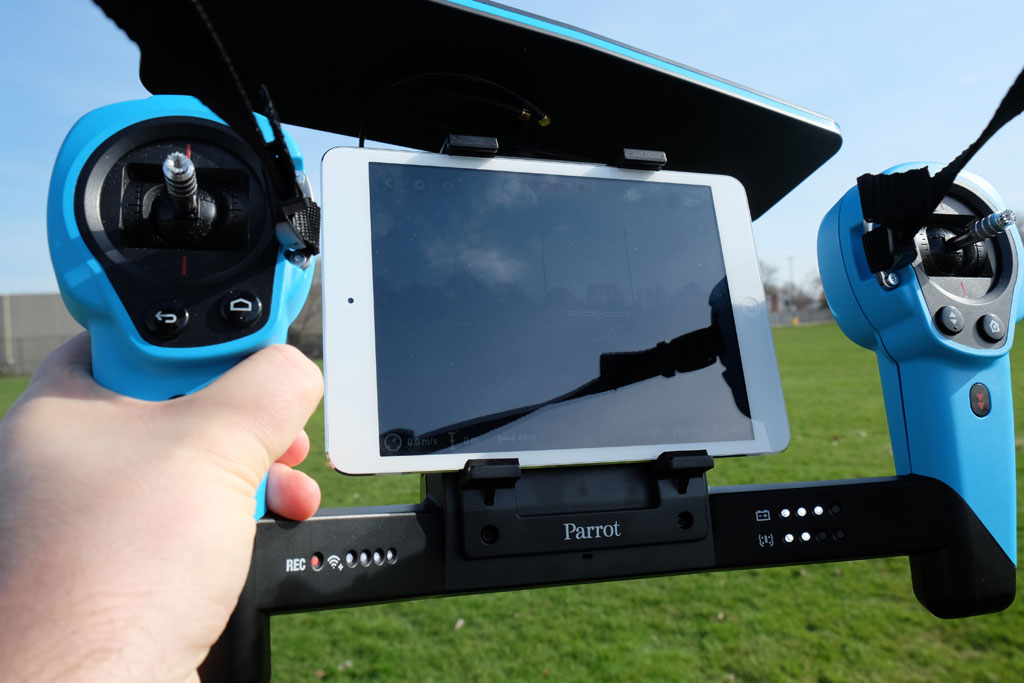
SkyController
When connected to a smartphone or tablet, it can roam up to 650 ft. away, but that’s extended all the way to just under 2 km when using the SkyController unit. Sold separately, or in a bundle with the Bebop, the unit looks like a cross between a miniaturized arcade and a cigarette tray from at a casino. The device can be an enhanced controller for the Bebop, offering better precision in elevation, movement and orientation through dual joysticks.
There is a mount in the middle to accommodate tablets of varying sizes. The internal Wi-Fi antenna is considerably more powerful than that of a tablet, allowing for the kind of range that could almost be scary. The SkyController also uses the same exact battery the Bebop uses, which could come in handy when you want to keep flying and use a phone or tablet to pilot instead.
Mind you, this isn’t likely to be a one-off product because the SkyController should have no problem working with future Parrot drones. I must admit, I had an easier time maneuvering the Bebop when using it, mainly because it was finely tuned and had the tactile feeling of joysticks and buttons. I didn’t have to look down at the screen to see what I was doing. Instead, it was only to see the drone’s point of view and adjust the angle of the camera.
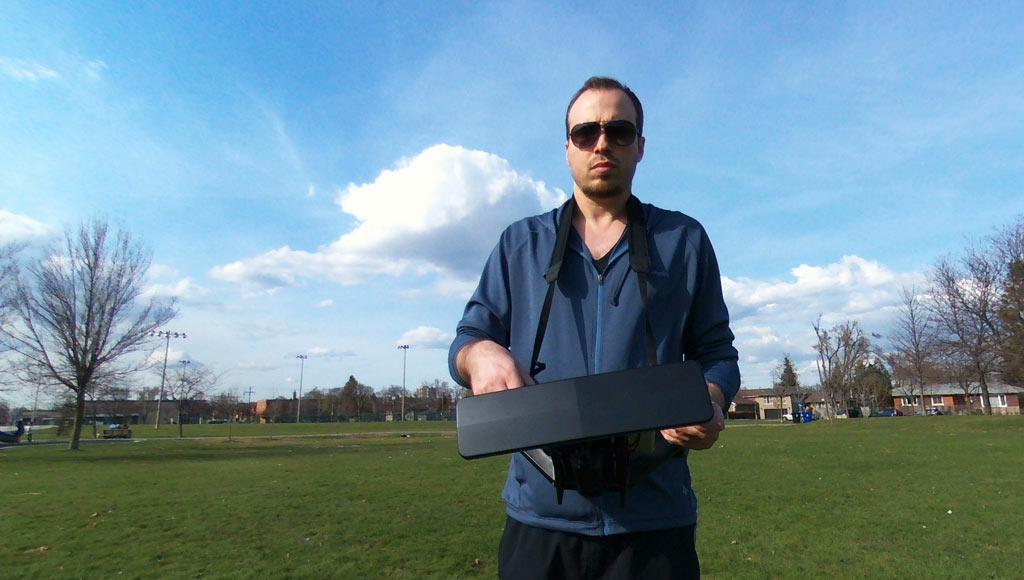
Camera and battery life
Image and video quality is a noticeable improvement from what Parrot has offered in the past. The Bebop is capable of capturing content that would be good enough for any budding amateur filmmaker or photographer. It’s not on par with more expensive drones that have better lenses and image sensors, but there’s still enough in the Bebop to warrant attempts at being creative with it.
The video shows some examples of what it can do, though it would’ve been nice to try using this in a more exotic location.
As for battery life, I managed about 10 minutes of flying time per charge. That’s below Parrot’s stated 12 minutes, though I imagine I could’ve stretched it closer to 12 if I had let the drone hover more and performed fewer tricks. Thankfully, the Bebop comes with two batteries, so swapping them can double flight time in one outing. The flying time did feel too short in most instances, but I could understand that with all the processing, navigation, sensors and camera going at once, it’s hard to pack in a battery with enough juice to keep it going for a lot longer.
Final Thoughts
As fun as it is to fly a drone, it’s still a niche activity. The Bebop shortens the learning curve by adding greater stability in the air, though it will take time to feel completely comfortable in exploring its limits. The SkyController expands those limits and makes it easier to pilot the drone, but isn’t a requirement to get the thing off the ground. It’s clearly aimed at enthusiasts who want to feel a unique experience when flying it around.
Check out the Parrot Bebop drone and SkyController available at Best Buy now in either blue or red.


